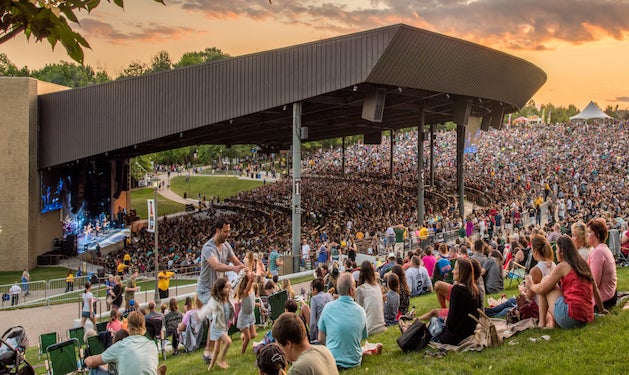Joan Baez
Starting her set at 1:30 a.m., Joan Baez was the closing act on Woodstock’s first day of music, and her performance was a fitting ending to a day of folk and traditional music.
Day One, Performer 8: Joan Baez
Performed Saturday morning, August 16, 1:30–2:15 am
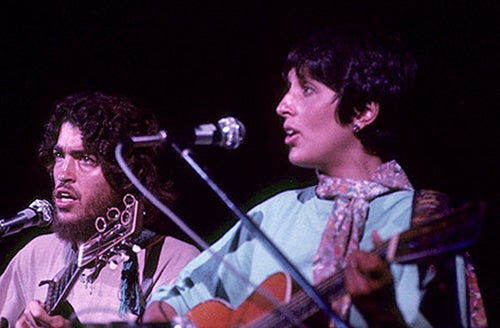 Joan Baez and Jeffrey Shurtleff performing at the Woodstock festival.
Joan Baez and Jeffrey Shurtleff performing at the Woodstock festival.
Joan Baez Band Members
- Joan Baez: vocals, guitar
- Richard Festinger: guitar
- Jeffrey Shurtleff: vocals, guitar
Joan Baez Woodstock Setlist
- Oh Happy Day
- The Last Thing on My Mind
- I Shall Be Released
- Joe Hill
- Sweet Sir Galahad
- Hickory Wind
- Drug Store Truck Drivin’ Man
- I Live One Day at a Time
- Take Me Back to the Sweet Sunny South
- Warm and Tender Love
- Swing Low, Sweet Chariot
- We Shall Overcome
Joan Baez has been folk royalty from the moment she took the stage at the Newport Folk Festival in 1959. Her clear, strong voice and political activism helped define the growing Greenwich Village folk scene, and, for a time, she was queen to Bob Dylan’s king. She performed at the Lincoln Memorial the day the Rev. Dr. Martin Luther King, Jr. gave his riveting “I Have a Dream” speech at the March on Washington, and she lent her voice to immigrant labor demonstrations, anti-war protests, and other causes she believed in.
Joan Baez was born on January 9, 1941, on Staten Island, New York, one of three daughters of a Mexican-born physicist father and a mother with Scottish roots. The family moved to southern California, where Joan spent much of her childhood, then relocated to Cambridge, Massachusetts so her father could join the faculty at MIT. Joan enrolled in Boston University’s theater school but soon lost interest. She was, instead, drawn into the burgeoning Boston folk music scene. Her early influences included Harry Belafonte, Odetta, and Pete Seeger. On the strength of her club performances around Boston, musician Bob Gibson invited the eighteen-year-old Baez to perform at the Newport Folk Festival in 1959, and her strong, beautiful soprano voice captured the audience.
Impressed by her Newport performance, representatives at Vanguard Records and Capitol Records rushed to sign Joan to a recording contract. She chose Vanguard, believing that the less-corporate label would give her more freedom. Her first album, the self-titled Joan Baez(Vanguard, 1960) reached the Top 20, an improbable feat for an album of traditional folk ballads at that time. Joan’s premier album and her next two albums, Joan Baez, Vol. 2and the live Joan Baez in Concert, all achieved Gold Record status, establishing Joan Baez as a star.
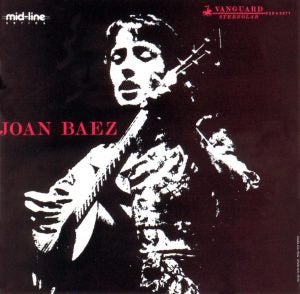
At the same time, Baez recognized a rising star in the folk music scene of Greenwich Village—Bob Dylan. She included his songs in her live performances, they often performed together, and they had an intense two-year romance that deeply affected both of them. Together, they were not only seen as the king and queen of folk music, but they were seen as spokespeople for civil rights and social issues of the day. But their paths were not meant to be parallel for long. Dylan embraced electric music, folk-rock, and apolitical songwriting, leaving the banner of “the cause” to Baez.
In a recent Rolling Stone feature about her, David Browne called Joan Baez the “moral center of the anti-war and social-justice movements that rose up in the sixties.” She sang “We Shall Overcome” at the 1963 March on Washington on the very steps upon which the Rev. Dr. Martin Luther King, Jr. gave his pivotal “I Have a Dream” speech. She went to jail for her protests against the war in Vietnam, and she performed for benefits, rallies, and protests for free speech and against the war that captured the public’s—and politicians’—attention. She blocked entrances to draft induction centers and symbolically withheld a portion of her federal taxes to protest U.S. military spending.
Joan Baez’s music continued to chart well through the 1960s. “We Shall Overcome” reached the Top 40 in the U.K. in 1965, and she scored Top 10 singles in the U.K. with “There But for Fortune” and Dylan’s “It’s All Over Now, Baby Blue.” In 1968, she married draft activist David Harris, and the following year released her 11th album, David’s Album. Recorded in Nashville, David’s Albumtakes a turn toward a more country sound, a nod toward her husband’s preference for country music. This, along with her ten other albums released to that time, would be the Joan Baez catalog by which the Woodstock audience would know her in the summer of 1969.
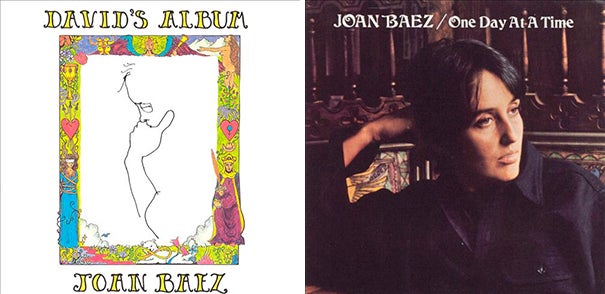
At 1:30 am on the first night of the Woodstock festival, John Morris announced “the fabulous lady,” Joan Baez, to the audience. She walked out to a single microphone, stood in the spotlight, commented on how it seemed as though hers would be a sunrise performance (not quite), and performed The Edwin Hawkins Singers’ arrangement of the traditional “Oh Happy Day.” She urged the crowd “to sit down…please,” and started singing the “oh happy day” part in her low register, switching to a high register for the “he taught me how” part of the song. From that moment, the audience was hers.
Next, Baez played “The Last Thing on My Mind,” a simple love song by Tom Paxton, followed by Dylan’s “I Shall Be Released.” For this song, Baez was joined by Richard Festinger and Jeffrey Shurtleff on guitars. The three musicians stood, spotlit on a dark stage that was framed by strings of bare lightbulbs. After explaining to the audience about how “m’ husband David” was doing well in federal prison and telling a story about how the marshals had gotten lost when they came to arrest him, Baez performed an organizing song, “Joe Hill” with Fresinger accompanying her on guitar while Shurtleff sat cross-legged to her right. She then sang one of her own songs, “Sweet Sir Galahad,” which she told the audience was written about her brother-in-law. For this song, Baez used a finger-picking style of playing that was different from her usual strumming style.
Fresinger and Shurtleff joined Baez again for the Gram Parsons song, “Hickory Wind,” followed by another Parsons song (co-written by Byrds bandmate Roger McGuinn), “Drug Store Truck Drivin’ Man,” which Shurtleff dedicated to then-California governor Ronald “Ray Gun.” On Willie Nelson’s “I Live One Day at a Time,” Jeffrey Shurtleff played guitar and sang harmonies to Baez’s melody, while Richard Festinger selectively played guitar fills to give the song a rich sound. They followed this with a Jerry Garcia/David Grisman song, “Take Me Back To The Sweet Sunny South” and “Warm and Tender Love,” popularized by Percy Sledge, after which Baez’s accompanists left the stage for the final song of her set, “Swing Low, Sweet Chariot.” Baez sang the traditional song a cappella, and her soaring high notes pierced the late night/early morning darkness. She left the stage, returning for a solo encore: “We Shall Overcome.” Accompanying herself on guitar, she gave the audience cues to sing along with her as she performed the venerable Civil Rights Movement classic. Even those who could not see the stage or who had already found their way to their campsites or sleeping bags recount their memories of that pitch-perfect voice reassuring them that all was good for the night.
Joan Baez’s Woodstock performance was immortalized on the soundtrack album and movie, but her legacy and her career did not need the boost. Joan Baez was already a part of the culture and a beloved singer of truth. After Woodstock, she continued her music career, touring and recording albums that ranged from gospel to traditional folk to pop. Her 1971 version of The Band’s “The Night They Drove Old Dixie Down” made the Top 10 in the U.K. and the Top 5 in the U.S., and her 1975 album Diamonds & Rust is widely acclaimed as her best. She recorded her 24th studio album, produced by Steve Earle, in 2008 and celebrated her 75th birthday in 2016 with a concert at New York’s Beacon Theatre with friends Judy Collins, David Crosby, Mary Chapin Carpenter, Jackson Browne, The Indigo Girls, and Paul Simon. She has written two books about her career, was the subject of a PBS American Masters documentary, and received a Lifetime Achievement Award at the Grammys in 2007. Joan Baez was inducted into the Rock and Roll Hall of Fame in 2017.
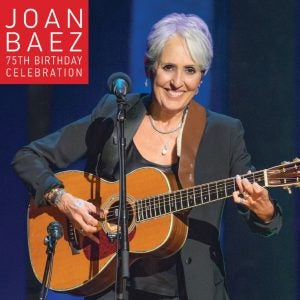
Joan Baez’s marriage to David Harris ended in 1972, but the son they had together, Gabriel (Gabe) is still very much a part of her life. She was pregnant with Gabe at Woodstock, and in 2013, the mother and son visited The Museum at Bethel Woods the day Baez performed at Bethel Woods Center for the Arts.
Baez has also continued her political activism, protesting a proposed building on the site of the Kent State massacre and speaking out for environmental and humanitarian causes and against landmines and oppression. In the 1970s, she helped establish the west coast branch of Amnesty International. According to David Browne in his recent Rolling Stone article, “rock is entering a new protest era, and Baez is helping lead the way.” She performed at Standing Rock to protest the Dakota Pipeline, performed at two Women’s Marches in one day recently in California, and is reportedly helping to plan a benefit concert in support of undocumented immigrants.
Jeffrey Shurtleff, who accompanied Joan Baez at Woodstock, had lived on a commune with his brother Bill and friend David Harris (Baez’s future husband) in the early 1960s and has been an anti-war activist ever since. After Woodstock, he appeared on Baez’s One Day at a Timealbum (1970) and recorded several other albums in Nashville, including his own State Farm in 1971. He then hitchhiked from California through South America for two years, later starting The Printers Inc. Bookstore in Palo Alto, California and Central Park Bookstore in San Mateo. He married, had two children, divorced, and was the director and head instructor of several youth schools in San Francisco. He now lives with his second wife and their daughter in San Bruno, California.
Richard Festinger, who also played guitar with Baez at Woodstock, has a B.A. in music, magna cum laude, from San Francisco State University and earned his Ph.D. in music composition at the University of California, Berkeley. For a number of years, he performed as a jazz guitarist and is the founding director of Earplay, a Bay Area chamber music ensemble. He is a professor of theory and composition at San Francisco State University, where he directs the Morrison Artists Series, presenting free chamber music concerts.
—Wade Lawrence & Scott Parker
